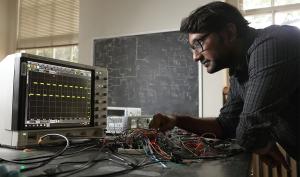
Technologies debuted at the annual Consumer Electronics Show likely began their journey to market at the International Electron Devices Meeting, the biggest yearly conference for researchers and engineers to introduce novel transistors and electronic devices to leaders in the semiconductor industry.
Electrical engineers at the University of Virginia School of Engineering and Applied Science earned a coveted invitation from conference organizers to present their paper, Overcoming the Accuracy vs. Performance Trade-off in Oscillator Ising Machines, which advances a new type of chip to solve computationally hard problems.
Antik Mallick, an electrical engineering Ph.D. student, first-authored the team’s paper. Mallick is a member of the Computing Hardware Research Lab led by Nikhil Shukla, assistant professor of electrical and computer engineering and materials science and engineering.
“Solving a computationally hard problem typically requires enormous time and memory,” Mallick said. “The circuit architecture in use today is not optimized for the level of complexity found in large-scale networks that drive social media, wireless communications, advanced manufacturing or drug discovery, for example.”
Shukla is leading a trend in analog computing and using oscillators to compute. Shukla provided proofs-of-concept in papers published in Nature Communications and the Institute of Electrical and Electronics Engineers’ IEEE Journal on Exploratory Solid-State Computational Devices and Circuits.
To take the next step toward a functioning prototype, Mallick reached out to Dan Truesdell, who earned his Ph.D. in electrical engineering from UVA in 2021 and was co-author of the paper. Truesdell was finishing his dissertation research in the Robust Low-Power VLSI Group led by Benton H. Calhoun, professor of electrical and computer engineering.
“I’m interested in electrical implementation,” Truesdell said. “What arrangement of transistors gives the best electric performance? What’s the minimum amount of energy you need to do those operations? That’s the part I’m most curious about.”
Mallick’s physics-based approach provided the blueprint to build an actual working circuit. The whole system is four millimeters square and uses less than 25 milliwatts of electrical power, about 1,000 times less than a light bulb.
“The paper we presented answered an unknown about the oscillator-based chip’s ability to scale — to make the leap from a 30-oscillator system that handles approximately 1,000 couplings, to a 600-oscillator system capable of handling approximately 30,000 reconfigurable couplings,” Mallick said.
Their chip also achieves a 100-times improvement in computation with the same accuracy as conventional digital computing.
“From my perspective as a circuit designer, the underlying idea of computing with oscillators is really, really sweet,” Truesdell said. “There’s a lot of progress to be made yet in circuit implementation. Beyond electrical properties, we need to test the limits in functionality and find the best way to interface with a traditional computer.”

Shukla earned a grant from the National Science Foundation’s Addressing Systems Challenges through Engineering Teams program, commonly known as ASCENT, to develop his computational model into a new hardware system nicknamed FerroCoDE.
To undertake this cohesive, across-the-stack effort, Shukla is partnering with Jon Ihlefeld, UVA associate professor of materials science and engineering and electrical and computer engineering; Mircea Stan, Virginia Microelectronics Consortium Professor of electrical and computer engineering; and Vijaykrishnan Narayanan, the A. Robert Noll Chair of computer science and engineering and electrical engineering at Pennsylvania State University.
“I am lucky to work on something I’m excited about, a real field where advancement can be made, where research is useful,” Mallick said.
Mallick delivered the team’s paper in person at the conference in December, taking the opportunity to discuss the team’s ideas for oscillator-based computing with industry representatives.
“I received very helpful feedback, mostly on the applications side,” Mallick said. “This insight gives us specifications for a scaled-up system that meets real-world industry needs.”
Truesdell hopes to see more conferences accept papers that combine computational theory and circuitry.
“It was neat to carry over concepts from traditional chip design to a totally new problem,” Truesdell said. “Our paper is a grade-A example of how cool collaboration can be when working at a place like the Link Lab (UVA’s cyber-physical systems lab). I am super glad I was able to fit that into my research experience at UVA.”